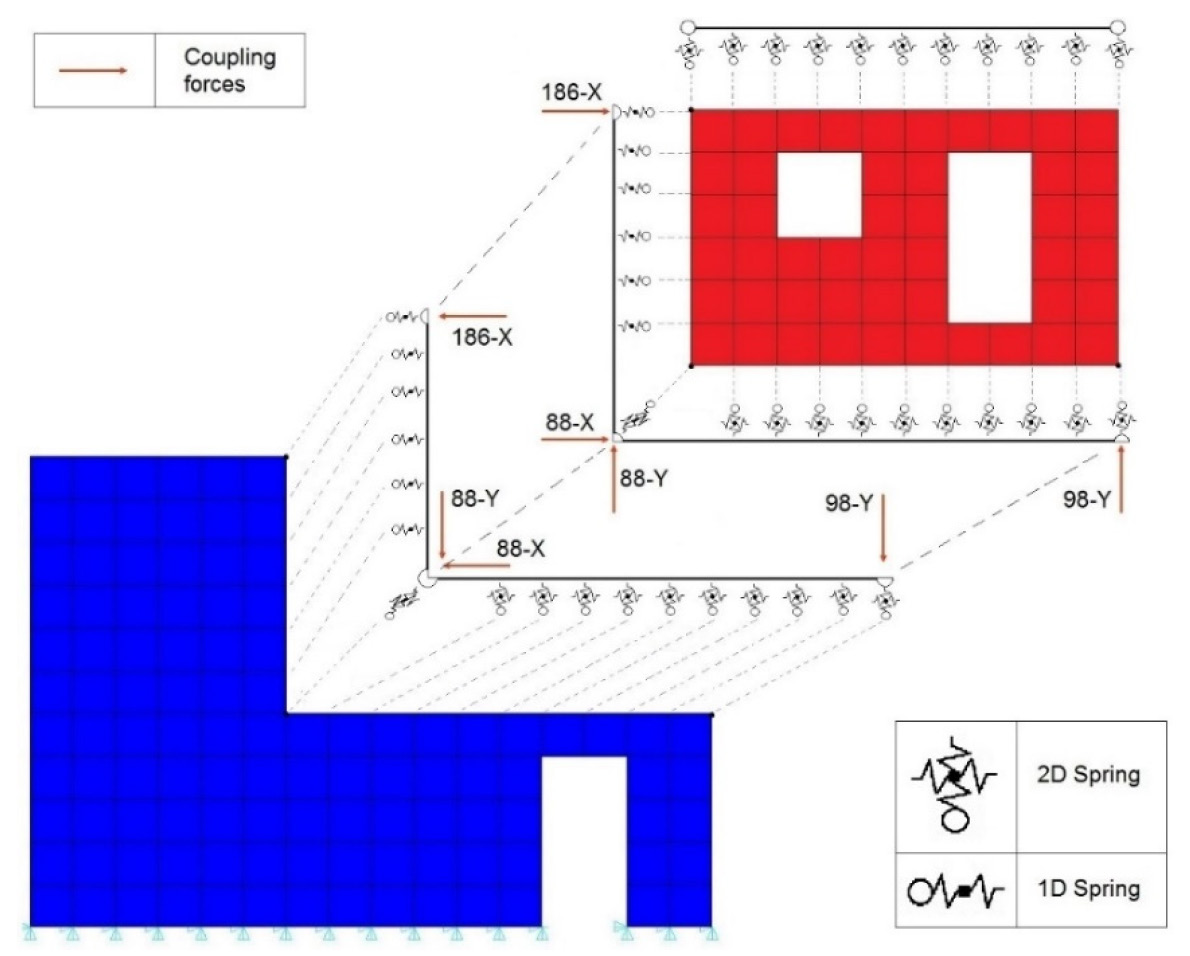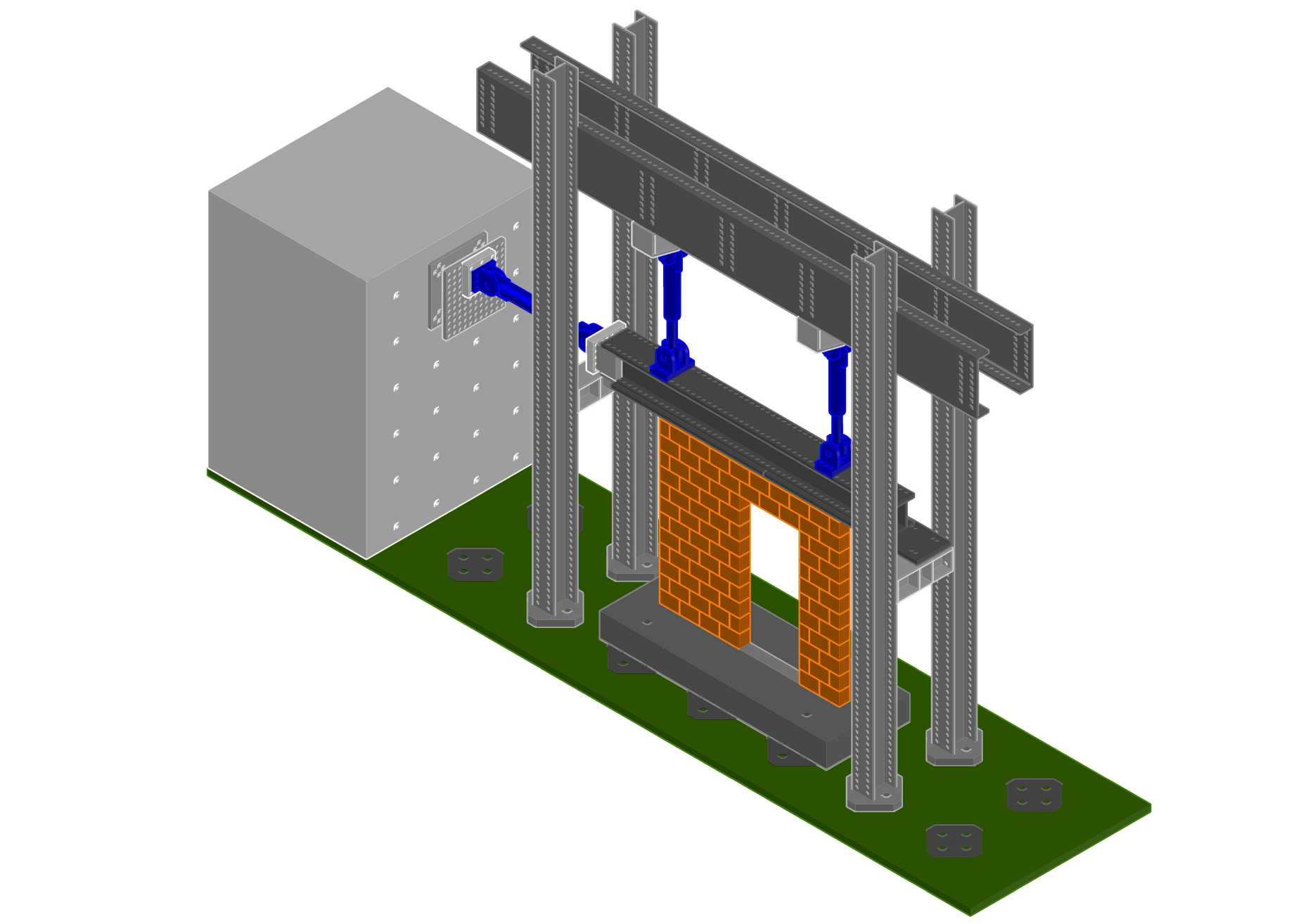Hybrid Testing of Structural Masonry
Hybrid simulation is a method that provides an important tool for investigating the behaviour of structural systems that are too large or too complex to be tested in the laboratory. Hybrid simulation is applied to determine the dynamic response of structures using hybrid models comprised of a numerical subdomain (NS), implemented in software, and a physical subdomain (PS), realised in a laboratory. By combining both numerical and physical analysis, it has decisive advantages over methods focusing only on one approach. The numerical subdomain allows the implementation of a less extensive test set-up when a part of the structure is analysed as a numerical substructure. On the other hand, the experimental approach permits one to determine the structural response of a strongly nonlinear subdomain, which would have been difficult to model numerically. The research project is conducted together with Prof. Dr. Bozidar Stojadinovic (Chair of Structural Dynamic and Earthquake Engineering) of our Institute and external pageProf. Dr. Giuseppe Abbiaticall_made of Aarhus University in Denmark.
Hybrid simulation has been extensively applied for the seismic response history analysis of steel and concrete frame structures. In the case of planar masonry structures, which are the main area of interest here, distributed interfaces characterize system subdomains and, in principle, several actuators should be used to impose the correct boundary conditions on the tested specimen. Two major advances were made in this research area at ETH Zurich. One is a new sub-structuring method for planar masonry substructures, which aims at reducing the number of actuators necessary to achieve a predetermined coupling accuracy between physical and numerical subdomains. The numerical validation of this procedure has been illustrated for a masonry building facade system. Figure below shows the masonry facade that has been investigated.
A new substructuring method for performing hybrid simulation of planar masonry structures, which are characterized by distributed physical and numerical subdomain boundaries has been introduced. Rigid interface super-elements are introduced to impose affine displacement fields at subdomain boundaries with a reduced number of connection degrees-of-freedom, which allows for reducing the number of actuators of the relevant experimental setup. In detail, rigid beam and link elements forms the NS interface super-element while steel frames, anchors and connection rods form the PS interface super-element. The numerical validation of this procedure is illustrated for a planar masonry facade system, which is virtually substructured using a typical three-actuator test setup for quasi-static cyclic testing of masonry wall specimens.
The details of the method and the results of this phase of the work are presented in following (awarded) publication:
G. Abbiati, G. Miraglia, N. Mojsilović and B. Stojadinović: "external pageHybrid Simulation with Dynamic Substructuring of Masonry Structures: A Numerical Studycall_made", Proceedings, 13th Canadian Masonry Symposium, Halifax, Canada, June 4-7, 2017, Paper No. 75.
The second topic is the hybrid testing of single-storey masonry walls with an asymmetrical door opening. Several static-cyclic tests were conducted on the two test specimens subjected to the 1979 Montenegro earthquake at different scales. In order to compare these results with the ones obtained from purely static-cyclic loading an additional wall has been tested. The physical specimens were tested in the laboratory at ETH Zurich and provided stiffness and damping parameters. Figure below depicts the test set-up with one of the masonry specimens. The seismic excitation was applied to the specimen in the form of horizontal displacements applied at the top of the specimen via a servo-hydraulic actuator. For each domain, equations of motion are expressed in a state-space form and solved via a state-space time integration algorithm to obtain the time-history response of the system. In detail, a set of servo-controlled actuators impose interface displacements and velocities to the PS and measure corresponding restoring forces. Analogously, a structural analysis software computes the NS restoring force response. Both restoring force vectors enter the coupled equation of motion of the prototype structure. Then, the simulation moves to the next time step. The simulation of NS and the testing of PS are parallel tasks that exchange interface forces and displacements at each step of the time integration loop.
The results of the second phase are presented and discussed in detail in the following publications:
- E. Goerens: "Hybrid testing of masonry walls", Master Thesis, ETH Zurich, 2018.
- R. Salzmann: "Statisch-zyklischer Versuch an einer Mauerwerkswand mit Türöffnung", Master Thesis, ETH Zurich, 2019.
- G. Miraglia, M. Petrovic, G. Abbiati, N. Mojsilovic, and B. Stojadinovic: "external pageA Model-Order Reduction Framework for Hybrid Simulation based on Component-Mode Synthesiscall_made", Earthquake Engineering and Structural Dynamics, 49 (8), 2020, pp. 737-753.
- M. Kovarbašić, R. Salzmann and N. Mojsilović: "Static-Cyclic Tests on Masonry Wall with Asymmetric Opening", Proceedings, 14th Canadian Masonry Symposium, Montreal, Canada, May 17-20, 2021, Paper No. 26.
The structural response from the hybrid simulations shows, in the linear elastic range, a close match with the purely numerical simulation but deviates when the physical domain reaches inelastic behaviour.


